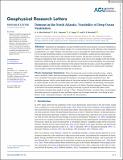Demons in the North Atlantic : variability of deep ocean ventilation
Abstract
Translation of atmospheric forcing variability into the ocean interior via ocean ventilation is an important aspect of transient climate change. On a seasonal timescale in the subtropics, this translation is mediated by a so-called "Demon" that prevents access to all except late-winter mixed-layer water. Here, we use an eddy-permitting numerical circulation model to investigate a similar process operating on longer (interannual) timescales in the subpolar North Atlantic. We find that variations in atmospheric forcing are mediated in their translation to the ocean interior, with year-to-year changes in the late-winter mixed layer depth being the critical factor. The signature of persistent strong atmospheric forcing driving deep mixed layers is preferentially ventilated to the interior when the forcing is ceased. Susceptibility to this effect depends on the location and density of subduction-with the rate at which newly ventilated water escapes its region of subduction being the crucial factor.
Citation
MacGilchrist , G A , Johnson , H L , Lique , C & Marshall , D P 2021 , ' Demons in the North Atlantic : variability of deep ocean ventilation ' , Geophysical Research Letters , vol. 48 , no. 9 , e2020GL092340 . https://doi.org/10.1029/2020GL092340
Publication
Geophysical Research Letters
Status
Peer reviewed
ISSN
0094-8276Type
Journal article
Description
G. A. MacGilchrist is supported through NSF’s Southern Ocean Carbon and Climate Observations and Modeling (SOCCOM) Project under the NSF Award PLR-1425989, with additional support from NOAA and NASA. HJ and DM were supported by the UK Natural Environment Research Council OSNAP project (NE/K010948/1). C. Lique was supported by the project MEDLEY funded by JPI Climate and JPI Oceans, under the agreement ANR-19-JPOC-0001. The hindcast was carried out within the European Drakkar project.Collections
Items in the St Andrews Research Repository are protected by copyright, with all rights reserved, unless otherwise indicated.

